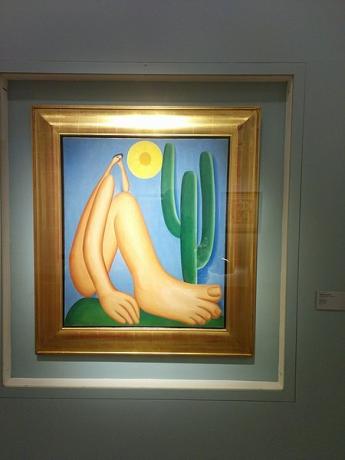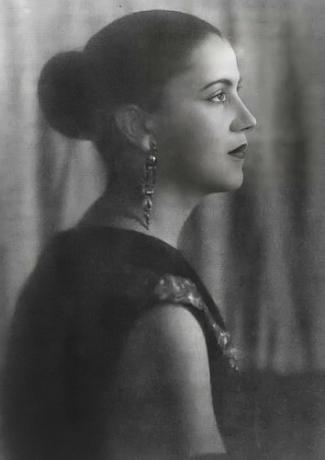Abaporu is the most famous work of the modernist painter Tarsila do Amaral. This painting brings the national colors (green, yellow and blue), has surrealist traits and praises the Brazilian cultural diversity. Inspired by this canvas, the writer Oswald de Andrade wrote the Manifesto Anthropophagus, which also seeks to determine the national identity.
Read too:Anita Malfatti — the painter considered the forerunner of modernism in Brazil
Topics of this article
- 1 - Summary about Abaporu
- 2 - Meaning and analysis of the work Abaporu
- 3 - History of the work Abaporu
- 4 - Cannibal movement
- 5 - What is the importance of the work Abaporu?
- 6 - Life of Tarsila do Amaral
- 7 - Some readings of the work Abaporu
Summary about Abaporu
Abaporu is a work by the modernist painter Tarsila do Amaral.
The painting has a nationalist character and values Brazilian miscegenation.
It was created by Tarsila with the aim of presenting Oswald de Andrade.
Inspired by this gift, Oswald de Andrade wrote the Anthropophagous Manifesto.
The anthropophagous movement values the Brazilian cultural multiplicity.
Meaning and analysis of the work Abaporu
The work Abaporu, from 1928, has brazilian elements, such as: the yellow of the Sun, the green of the cactus, the blue of the sky.
These colors are present in Brazil's flag, thus demonstrating the nationalist aspect of this painting. The individual portrayed has dark skin and represents the brazilian miscegenation. He has his face resting on his hand, which suggests a reflective attitude and takes us back to sculpture. The Thinker, by the Frenchman Auguste Rodin (1840-1917).
In this way, the painter Tarsila do Amaral makes a dialogue between tradition and innovation, given that Abaporu it also has surrealist traits, as it portrays a human figure in disproportionate shapes and, therefore, far from reality and closer to a dreamlike universe.
Abaporu é one of the main works of modernist painting in Brazil, produced in the early years of the mBrazilian modernism. Hence its nationalist character and the visible enhancement of the identity of the Brazilian people, marked by the cultural diversity arising from miscegenation.
Do not stop now... There's more after the publicity ;)
History of the work Abaporu

Until then Abaporu was a present that the painter Tarsila do Amaral decided to give to her husband, the writer Oswald de Andrade(1890-1954), on his birthday, January 11, 1928. Excited about the present, the writer soon made his interpretation and considered the portrayed figure an anthropophagous.
After consulting a dictionary, the painter and the writer named the recent work Abaporu. Of Tupi-Guarani origin, the term tab means “man”; already poru, “that eats”. Tarsila's canvas inspired the author to write the Manifesto Antropofágico.
cannibal movement
The anthropophagic (or anthropophagic) movement It is related to first phase of mBrazilian modernism. Its foundations are expressed in the Anthropophagous Manifesto|1|, written by Oswald de Andrade in 1928. In essence, this document advocates a kind of cultural anthropophagy.
Therefore, is against a radical nationalism, since its author understands and accepts that Brazilian culture is the result of various influences. Thus, it encourages the artist to, metaphorically, “eat the foreigner”, that is, assimilate what is good at culture foreign and imprint something typically Brazilian on it.
Here are excerpts from the manifest:
I only care about what is not mine. Law of man. Law of the Anthropophage. […] We were never catechized. We live through a sleepwalking right. We made Christ born in Bahia. Or in Belém do Pará. […] Against Father Vieira. Author of our first loan, to earn commission. The illiterate king had told him: put this on paper but without too much lip service. The loan was made. Brazilian sugar was recorded. Vieira left the money in Portugal and brought us the lip service. […] We were never catechized. We did Carnival. The Indian dressed as a senator of the Empire. Pretending of Pitt. Or appearing in Alencar's operas full of good Portuguese feelings. […] I asked a man what the law was. He replied that it was the guarantee of the exercise of possibility. That man is called Galli Mathias. I ate it. […] But it was not the crusaders who came. They were fugitives from a civilization that we are eating, because we are strong and vengeful like the Tortoise. […] Before the Portuguese discovered Brazil, Brazil had discovered happiness.
In these excerpts gathered in our citation, it is possible to perceive the foreign influence, particularly Portuguese, in Brazilian culture, but also the view that our culture has something unique, a “happiness” prior to discovery and catechization. In addition, it also shows that we transform foreign elements into something typically Brazilian.
What is the importance of the work? Abaporu?
Abaporu it is a symbol of the anthropophagous movement and is also a symbol of Brazilian modernist art as a whole. The work also generates reflection on national identity, a theme so dear to modernists. It shows that, behind the green and yellow, there are also other colors (influences) in the national culture.
See too: Mona Lisa — one of the most famous paintings in the world
Life of Tarsila do Amaral
Tarsila do Amaral was born in 1º September 1886, in the city of Capivari in São Paulo. She later studied at the Sacré-Coeur de Jésus College in Barcelona, Spain, where she started painting. In 1906, she was back in Brazil, where she married for the first time. Already divorced, in 1920, she studied at the Julian Academy in Paris.

Two years later, in 1922, shejoined the mmodernism. That same year, with Oswald de Andrade, her boyfriend at the time, she went to live in Europe, only returning at the end of 1923. In addition to being a painter, Tarsila directed the Pinacoteca of the State of São Paulo. Farrived on January 17, 1973, in the capital of São Paulo.
Some reinterpretations of the work Abaporu
Abaporu, by Eloir Jr.
Abaporu, by Luciano Martins.
Abaporu, by Romero Britto.
Abaporu, by Valdsom Braga.
Abaporu do sertão, by Eduardo Lima.
Auauporu, by Tarik Klein.
Note
|1| ANDRADE, Oswald de. The Anthropophagic Manifesto. In: TELES, Gilberto Mendonça. European avant-garde and Brazilian modernism: presentation and critique of the main avant-garde manifestos. 3. ed. Petrópolis: Voices; Brasília: INL, 1976.
image credits
[1] Paulo José Soares Braga | Brazil School
[2] Wikimedia Commons (reproduction)
[3] Public domain | commons
By Warley Souza
Literature Teacher
Find out who Anita Malfatti was, considered a precursor of modernism in Brazil. Know your artistic style and its importance. Check out her works.
Learn more about Modernism in Brazil, its historical context, its European influences and proposed ruptures. Check out its stages, main works and artists.
Understand who Oswald de Andrade was and what his main works were. Learn about its literary characteristics and understand its role in Brazilian modernism.
The elements and techniques that make up a painting.
Click here and learn details about the life and work of Romero Britto, an important Brazilian plastic artist.
Understand what the 1922 Modern Art Week was all about. Find out which artists participated, what happened each day and why this event was so important.
Know what are the characteristics of surrealism. Meet the main artists of this avant-garde movement and see how it influenced Brazilian artists.
Find out who Tarsila do Amaral was, read her biography, understand her relationship with Brazilian modernism and discover her most relevant works.
Click here and see what are the main characteristics of the European vanguards. Find out how they came about and what purpose they had.

